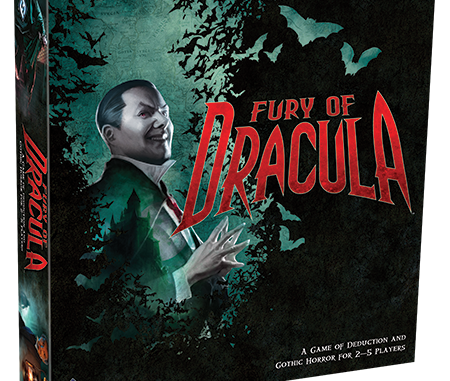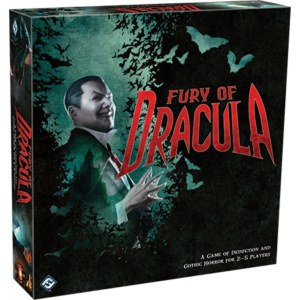
Fury of Dracula is a game that has long been very near and dear to my heart. In fact, I’ve already reviewed it once for this very blog. With new board games coming out all the time, however, and with modern design choices causing a lot of older titles to show their age in less-than-flattering ways, my own copy had sat in the corner for quite some time, sadly unloved.

Which is why I was very excited last year when I heard that Fantasy Flight Games was going to be releasing a Third Edition of this cult classic title. With nearly a whole decade having passed since the previous version came out, there was certainly a great opportunity to adjust the experience for the current day, and early promotional videos from Fantasy Flight themselves suggested (at least to me) that they were making the most of the opportunity.
But how would it all turn out, I still had to wonder: would there simply be minor tweaks and art changes that didn’t provide a terribly different experience, or would the game I’d known and loved for nearly ten years be changed into something unrecognizable?
Now that the game is out and I’ve had a chance to play it, let’s take a look at Fury of Dracula, Third Edition.
Overview
The general premise of the new version of Fury of Dracula is exactly the same as the previous version: the dreaded Count Dracula, believed to have been destroyed at the end of his titular novel, has returned eight years later, leaving Van Helsing, Dr. Seward, Lord Godalming, and Mina Harker to scour Europe for signs of him so they can track him down and eliminate him once and for all.
But Dracula is no easy prey. While he leaves a trail in his wake as he travels the continent in secret, he also leaves behind angry mobs and wicked creatures to stymie his pursuers, conjures up storms to make seas impassible, and even manipulates the press to throw the hunters off of his scent.
A co-op team of hunters challenges a Dracula player to see whether fiction’s most famous bloodsucker finally goes down for the count, or stays at large long enough to foster a new legion of vampires and secure his demonic dominion over Europe.
Gameplay and Gameplay Changes
If you’ve played the previous version of Fury of Dracula, the overall gameplay of the new edition will be very familiar to you: Dracula travels across Europe using a deck of cards to secretly mark his location and leaves nasty encounters in the cities he passes through, while the team of hunters searches for his trail and attempts to gear up with equipment and special event cards.
As mentioned above, I’ve reviewed Fury of Dracula in its previous incarnation already, so rather than rehash the similarities in exhausting detail, I’ll instead refer you to that review, and focus here on how and where the game is different.
Thankfully, in my experience so far, the changes have all been for the better. Most noticeable among them (and certainly most welcome) is a complete overhaul to the Second Edition’s biggest failing: the combat system.
Gone is the unnecessarily byzantine process of building either a daytime or nighttime deck, rolling dice, comparing initiative numbers, consulting a list of oft-unintuitive icons, and then determining whether your weapon is destroyed based on whether one card or another has bold italics on it (and that’s before resolving damage!). Now, Dracula simply draws a hand from his combat deck, the hunter characters form one from their own reserves, and each combatant plays a card in secret before they are revealed simultaneously; if one of the icons on the hunter’s card matches the icon on Dracula’s card (each of his cards have only one icon), then Dracula’s card is cancelled and only the hunter’s takes effect. Much, much simpler and far easier to explain–and gone are the pesky “continuance” results!
Another great change is the nature of the components for Dracula’s encounters. Previously, encounters were marked by simple square icons with an image on their face, and required consulting a rulebook to see what the encounter and effect was if you weren’t familiar with each individual image (and there were a lot!). Now, encounters are simply cards in their own right, with the rules for their effect written directly on them. I’ll admit I miss the look and feel of placing a square token atop the location card (laying a card slightly offset from another card doesn’t feel as elegant), but it’s a very small price to pay for a smoother play experience.
Turns and timing are tracked very differently now (and also for the better, in my opinion). Rather than three daytime turns followed by three nighttime turns, each turn now gets a daytime and nighttime phase, with the hunters’ two actions split between them–and with the added complication that the hunters cannot travel at night (a sensible move in late 1800s Europe when a vampire lord is out to get you!). Time also no longer “stops” when Dracula goes to sea, which is instead balanced by giving the hunters more options to discover his location while he’s there.
Speaking of timing, perhaps the most interesting change (as opposed to the probably necessary fixes to combat and rulebook-diving) is the addition of Despair Tokens. With each week that passes in-game, a new Despair Token is added to the board, essentially giving a scoring boost to Dracula each time he’d increase his Influence Track (essentially, his victory points), but at the cost that his sense of noble pride prevents him from fleeing from combat until he’s engaged his opponent for longer and longer lengths of time. Once a total of three Despair Tokens are on the board, Dracula starts to earn automatic victory points each time he gets a turn, acting as a sort of ticking clock for the hunters to find Drac ASAP or risk losing the game.
Other Minor Changes
The gameplay changes above are the most obvious and prominent, but there are some other, smaller tweaks to the game as well.
By and large, the four hunter characters have similar abilities this time around, changed mainly to account for the other rules changes in the game; likewise, Dracula’s special powers (such as Feed, Dark Call, and Wolf Form) are all back, again functioning largely as before.
Gone is the whole concept of Resolve for the hunters, though the abilities Resolve could be used to trigger have largely been duplicated with cards in the hunters’ event deck, instead. Similarly, Dracula’s victory point track has been expanded from 6 to 13, presumably because Dracula has more ways to gain Influence than before–and ways to increase the total Influence gained, which didn’t exist before.
In addition to the aforementioned Influence boost from Despair Tokens, Dracula now also receives Rumor Tokens at certain points, which he can place atop recent encounters he’s left behind. If the encounter in question is one of Dracula’s newly fostered vampires, he earns a hefty 3-point bonus; otherwise, it does nothing, but a clever Dracula player can use these to encourage hunters to divvy up their efforts to chase down an otherwise harmless encounter, or even a nasty trap, since they likely won’t want to risk Drac getting such a big boost to his score.
Gone are any and all dice, both for combat (as mentioned above) as well as the Train Die; instead, booking a train ticket is an action in and of itself, chosen from a facedown pool (reminiscent of Battlestar Galactica‘s civilian ship pool) which have numbers that determine how far a hunter can travel based on the railways used.
Drawing from the event deck is also different. Previously, hunters drew from the bottom of the deck, not knowing whether they’d be drawing a card for themselves or for Dracula; now, cards are only drawn from the bottom at night. During the day, the hunters draw from the top of the deck, where they can see whether it’s a Hunter card or Dracula card–and if it is a Dracula card, it is discarded, face-down, in lieu of the actual draw, robbing Dracula of some potentially powerful cards (and boy, are Dracula’s cards powerful this time around!). As with the previous edition, the event deck is stacked 2:1 in favor of the hunters.
One last interesting wrinkle is the nature of table talk and hunters sharing information: now, unless hunters are in the same city and actively trading, they cannot discuss things or show cards to one another in secret; otherwise, anything they say must be said openly, and if they want to show another hunter cards in their hand, they must also show Dracula. This works surprisingly well in practice, and I’ve seen firsthand how, in a late-game, do-or-die play, it might be worth letting Dracula know what’s up your sleeve if it allows the other hunters to coordinate with you unfettered.
Thoughts
My admitted fondness for this game and IP aside, I do feel that the Third Edition of Fury of Dracula is an objectively improved experience over the previous one. It’s still a somewhat complex game, and probably isn’t a good entry-level game for newcomers to the board gaming hobby, but it’s robust, faster-paced, and overall much less frustrating than it was.
There are still some issues, however. For instance, the game claims the Rules Reference guide supersedes the Learn to Play guide (a common FFG board game trope lately), but the errata indicates several points where the supposedly “definitive” Rules Reference is wrong where the Learn to Play guide is correct; it’s not an insurmountable issue, and there is an official errata and FAQ available, but it’s still somewhat vexing, especially in a few edge cases that are only made explicit in one guide or the other.
Still, overall, the good far outweighs the bad, and the actual gameplay changes themselves are, I feel, all for the better. If you weren’t fully on board with the Second Edition because of the occasional fussiness, give Third Edition a try–this version might succeed in hooking you where the last one failed.
Conclusions
PROS:
– still a robust cooperative board game experience with a competitive element
– still lots of variety in terms of the items and abilities Dracula and hunters can make use of
– addresses basically all of Second Edition’s shortcomings
– Dracula theme comes across even better, with a more fitting art design style
– vampires still don’t sparkle
CONS:
– still potentially intimidating for newcomers (especially for the Dracula player)
– yes, it’s another FFG board game with an error-laden rulebook
– a handful of strange edge cases that aren’t directly addressed in the rules
